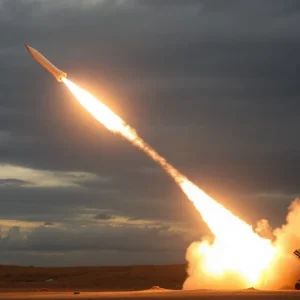Northern Lights Expected to Dazzle Across Multiple U.S. States This Weekend
City officials are gearing up for an enchanting light show as the Northern Lights are expected to be visible in several continental U.S. states this Friday night. This stunning experience comes after a series of powerful solar flares that have led to geomagnetic storms, perfect for viewers hoping to catch a glimpse of this natural spectacle.
The Cause Behind the Lights
Earlier in the week, the sun produced an impressive X7.1 solar flare on Wednesday followed by an even more powerful X9.0 flare on Thursday. This recent flare is the strongest seen in the sun’s current solar cycle, which is known as Solar Cycle 25. Notably, the flare that brought forth May’s bright auroras was charged with an X8.7 measurement.
These solar flares can result in coronal mass ejections, which are bursts of solar material that are responsible for creating Northern Lights sightings. Over the weekend, a pair of these CMEs is projected to affect Earth, occurring between Friday and Sunday.
Weather and Viewing Conditions
The National Oceanic and Atmospheric Administration (NOAA) initially issued storm watches ranging from minor to strong geomagnetic storms for Thursday through Saturday. However, these forecasts have now been revised to indicate strong G3 storms lasting into Sunday.
As for Friday night, the Kp index is predicted to hit five, suggesting that the lights will be quite vibrant and “pleasing to look at,” provided that weather conditions cooperate. Clear skies will be crucial as viewers look to enjoy this breathtaking experience.
Where to See the Northern Lights
Although the Northern Lights will likely be most vivid in regions like Canada and Alaska, several states in the continental U.S. will also be within the aurora’s view line. Potentially prime locations include:
- Washington
- Idaho
- Montana
- Wyoming
- North Dakota
- South Dakota
- Minnesota
- Iowa
- Wisconsin
- Michigan
- New York
- Vermont
- New Hampshire
- Maine
The lights are generally most active between 10 p.m. and 2 a.m., making these hours ideal for avid sky watchers.
Tips for the Best Viewing Experience
If you’re hoping to catch the Northern Lights, here are some tips to enhance your viewing experience:
- Travel as close to the poles as possible.
- Avoid city lights and other sources of light pollution.
- Stay informed by monitoring weather forecasts for favorable conditions.
- Find a good vantage point, like a hilltop, to maximize your view.
Interestingly, smartphone cameras can be quite effective for capturing the auroras, even when they are faint to the naked eye. Visitors to places known for Northern Lights sightings, like Iceland, suggest enabling night mode on your smartphone to enhance exposure.
The Solar Cycle and Future Activity
Looking ahead, Solar Cycle 25 is expected to peak between late 2024 and early 2026. Scientists predict that there will be an uptick in sunspots, which are centers of geomagnetic storms and crucial to creating Northern Lights. Although we’re not at the peak yet, recent months have shown elevated solar activity, indicating that we might see more noteworthy geomagnetic storms in the future.
In fact, August recorded an impressive average of 215.5 daily sunspots, the highest number since Solar Cycle 23 in 2003.
As enthusiasts prepare for another potential viewing opportunity this Friday night, excitement in the communities is palpable. Make sure to gather friends and family and look up at the sky; you just might witness the magical Northern Lights dance across the horizon.








